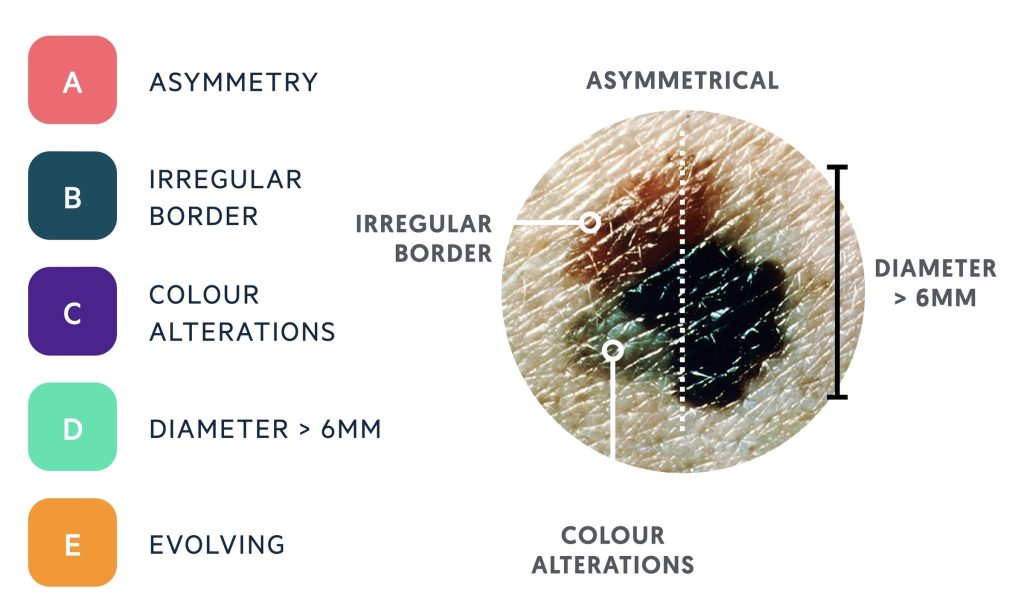Understanding Melanoma: Types and Treatment Options
Melanoma is the most serious type of skin cancer, and unfortunately, its incidence continues to rise in Australia—a trend we are seeing firsthand with the growing number of melanoma patients here at Ethique Plastic Surgery. Australia is one of the highest risk countries in the world for Melanoma due to our high UV exposure. Early detection and treatment are essential for the best outcome, which is why regular skin checks and awareness of changes in your skin are so important.
Statistics related to Melanoma

- 95% of melanomas are caused by overexposure to UV radiation from the sun
- There are around 16,000 new cases of Melanoma every year and approximately 1,300 people are expected to die from Melanoma this year.
- Survival rate is 96% for early diagnosis vs 63% for late diagnosis.
- Lifetime risk in men is 1/14 and in women is 1/23.
- Australia has the world’s highest rates of melanoma, which is the third most common cancer overall and the most common cancer for Australians aged 20-39.
What Is Melanoma?
Melanoma develops when pigment producing cells (melanocytes) in the skin grow and divide uncontrollably. It can then spread (metastasise) to other parts of the body if not treated early. Melanoma can develop on areas frequently exposed to the sun, but also in places not usually exposed, such as under nails or on the soles of the feet.
Types of Melanoma
There are several types of Melanoma, each with slightly different characteristics. The more prominent ones are listed below:
- Superficial Spreading Melanoma:
This is the most common form, usually appearing as a flat or slightly raised irregular patch. It may have varying shades of brown, black, or pink and tends to spread slowly across the skin before penetrating deeper. This type of Melanoma more common in younger patients. - Nodular Melanoma:
This is the second most common form of Melanoma. This type tends to grow more quickly and often appears as a raised, firm lump that is dark in colour (though sometimes pink or red). Because it can spread rapidly, early detection is critical. It has a higher mortality rate and usually occurs in older patients. - Lentigo Maligna Melanoma:
Typically occurs on sun-damaged areas such as the face, particularly in older people. It starts as a flat, slowly enlarging brown patch before invading deeper layers of the skin. - Acral Lentiginous Melanoma:
A rarer type that appears on the palms, soles, or under the nails. It is often diagnosed later because it can be mistaken for other skin changes. - Melanoma in situ:
This is the earliest stage of melanoma, where the melanoma cells are confined to the top layer of the skin and have not yet become malignant. As it hasn’t spread and if it is treated early, it is highly curable.
How Melanoma Is Treated
Treatment depends on the stage and type of Melanoma, as well as the patient’s overall health. However, the correct and best treatment is a two-stage approach. The first stage is surgical excision of the Melanoma with a minimal margin. Then, based on the pathology, Dr Safvat plans for the second stage which is usually a wider excision with a bigger margin around the site of the original excision. In some more severe cases, the patient may also be referred to the Melanoma Unit for further treatment. The further treatments that may be needed are:
- Sentinel Lymph Node Biopsy:
If the melanoma has certain high-risk features, a small number of nearby lymph nodes may be tested to check for early spread. - Immunotherapy and Targeted Therapy:
For advanced melanoma, medications can help the immune system recognise and attack melanoma cells, or target specific genetic mutations driving cancer growth. - Radiation or Chemotherapy:
These may be used in selected cases, especially when surgery isn’t an option or to help manage spread to other areas.
Prevention and Early Detection
Most melanomas can be successfully treated if caught early. Here are some tips on what you can do:
- Perform regular self-skin checks and look for new or changing moles.
- Follow the ABCDE rule: Asymmetry, Border irregularity, Colour variation, Diameter over 6mm, Evolving appearance.
- Book regular skin checks with your GP or skin specialist.
- Protect your skin daily with a TGA approved broad-spectrum SPF 50+ sunscreen, protective clothing, and shade, especially during peak UV hours.
At Ethique Plastic Surgery, we treat many patients with skin cancers each year and understand how vital early detection and proper surgical management are for the best outcomes. If you have noticed any changes in your skin or have concerns about a mole, please arrange a professional skin check.
